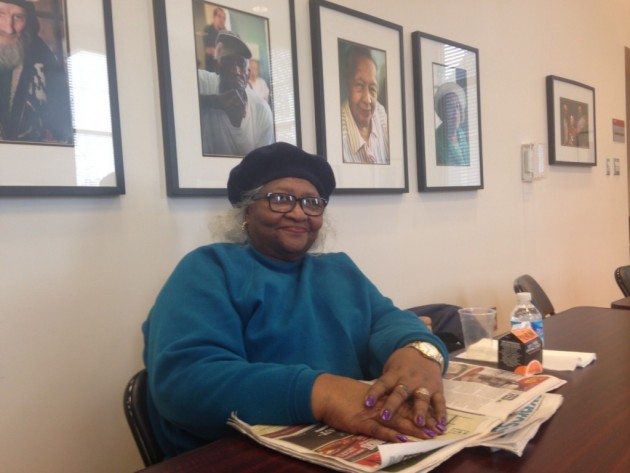Student Protest Enters Second Week

Howard University students have occupied the Admisitration Building for five straight days in protest of campus conditions. Photo by Alexa Imani Spencer/HU News Service
WASHINGTON – Howard University students, who have garnered national media attention and lots of followers after taking over one of the university’s buildings in protest, remained inside the building Monday for the fifth day.
The students have had multiple meetings with the university’s Board of Trustees, including Sunday night, and have gained one concession so far.
“One fruitful outcome of that discussion is that the deadline to submit the $200 housing deposit will be extended to May 1, 2018,” Vice President for Student Affairs Kenneth M. Holmes said in an email to the university. “If this extension results in a significant number of students requesting on campus housing, we will delay the … renovation [of one building] to accommodate the additional occupancy.”
The university also has agreed to discuss with students the possible revisions of the housing policy, which currently requires all first and second year students under the age of 21 live on campus unless they are living with a parent or guardian, Holmes said.
“The request from our students was met,” he said.
The student protest is being spearheaded by HU Resist, a student organization that has led several protests, including concerns about housing and the hiring of former FBI director James Comey.
Maya McCollum, 18, a freshman journalism major from Atlanta, Georgia, has been part of the negation team. McCollum said she was surprised that administration acquiesced to one of its nine demands.
“It’s really shocking, because we didn’t expect that they would consider any of our demands,” said McCollum, who said her room flooded and “It’s been leaking since day one.”
More than 100 students Thursday took over the university’s Administration Building, which houses the president’s office and most major offices that run the university.
Students are demanding action following a plethora of failures that have hit the campus since January, the embezzlement of a reported $1 million from the financial aid office and a failed revision of the system for housing students that left some “homeless” and resulted in an embarrassing email exchange between a distraught student and the president that caused he president to apologize. The university is also recovering from a major heating system failure in January that flooded buildings, destroyed or damaged classrooms, delayed the semester for a week and left many classrooms without heat and students without hot water and heat.
The repairs are so expensive that all department budgets are facing reductions, including the reductions in some of its adjunct professors.
The protest comes 50 years after a historic 1968 sit-in. The students said they are using a similar strategy to command change. They’re not leaving until their demands are met.
As students entered the building Thursday to join the protest, they were handed copies of a list of nine demands written by HU Resist.
The students’ demands includes a freeze on tuition increases, the ability to have input through popular vote on decisions by the administration and the Board of Trustees, and the immediate resignation of President Wayne A.I. Frederick.
HU Resist member Rozlyn Wingate, 18, said students will not cease their protest without the resignation of university President A.I. Frederick and the executive committee of the school’s Board of Trustees.
“The entire purpose of this sit-in is to make sure that we do not leave this space until our needs and the things that we require and want to see happen, happen,” she said.
Student-leaders have used the time inside the Administration Building to educate fellow protesters on “student power,” the idea that students hold the power in the university.
Many students brought sleeping bags in preparation for overnight stays. During the protests, students have returned to their homes to shower and take care of personal affairs and then return to the building.
Outside supporters, alumni and anonymous donors, have made food available to the protesters. Students devoured dozens of donated pizzas delivered to the front doors of the building. The emptied boxes lined the walls of the lobby.
As students ate, they discussed issues they want addressed, including what they say is the university’s inadequate response to campus rape and the need for more of mental health support.
Eric Powell, 21, a junior audio production major from Bowie, Maryland, said he wants the university to be true to its stated mission.
“Howard as an institution purports to stand for ‘truth and service,’ and stands for black people, simply because it’s a historically black university,” Powell said. “But if it’s running in the same way or in a similar fashion to how white institutions run or as a representation of this system in this country, we need to make sure that we either reform it or completely dismantle it and build it from the bottom up.”
The sit-in is in tradition of campus activism of the 1960s and 1980s, Powell explained. Without past student protests, the university would not be what it is today, he said. Many changes grew out of the protests, such as the establishment of the Afro-American Studies Department.
“It’s always been students’ job to hold the university accountable as an institution, to hold the administration accountable,” he said.
Anise Jenkins was a participant in the 1968 takeover. For four days, she and fellow students occupied the administration building, what she described as an empowering experience. Their purpose was to force Howard to create a stronger emphasis on African-American studies and black history, arts and culture.
“In 68’, we were tired of Howard University not centering the black curriculum,” Jenkins said. “We took over the administration building, and we held the administration responsible for the curriculum, for the lack of blackness at Howard University.”
Standing outside of the Administration Building, she talked with protesters, expressing her pride for the present-day student-body. She said that as students, the power is in their hands.
“It’s students who have the power to run the university,” she said. “It’s not the administration. It’s not the money. It’s the students. That’s why the university exists.”
Dae Parker, 19, a freshman elementary education major from Charlotte, N.C., said she did not expect to be involved in numerous protests when she enrolled in August.
“I really did not expect my freshman year to look like this,” Parker said.
She was hesitant to participate at first, she said, but now she is glad she did.
She said she hopes their efforts generate a dialogue between students and the administration about their concerns.
“I’d really like to see if the president could actually speak to us face-to-face and say his thoughts about what’s going on,” she said.





